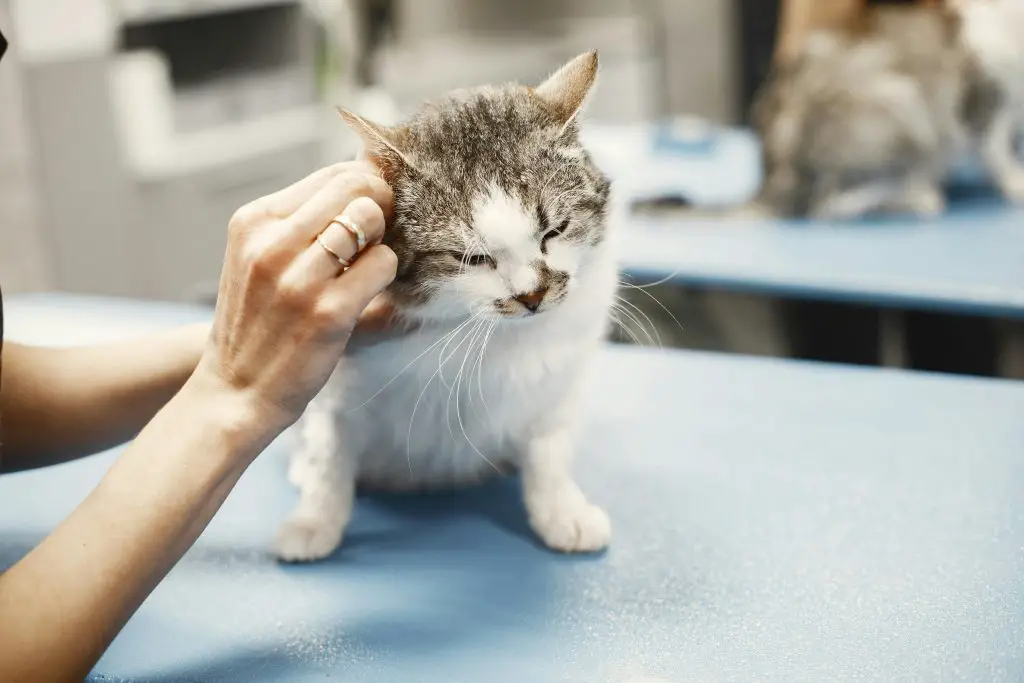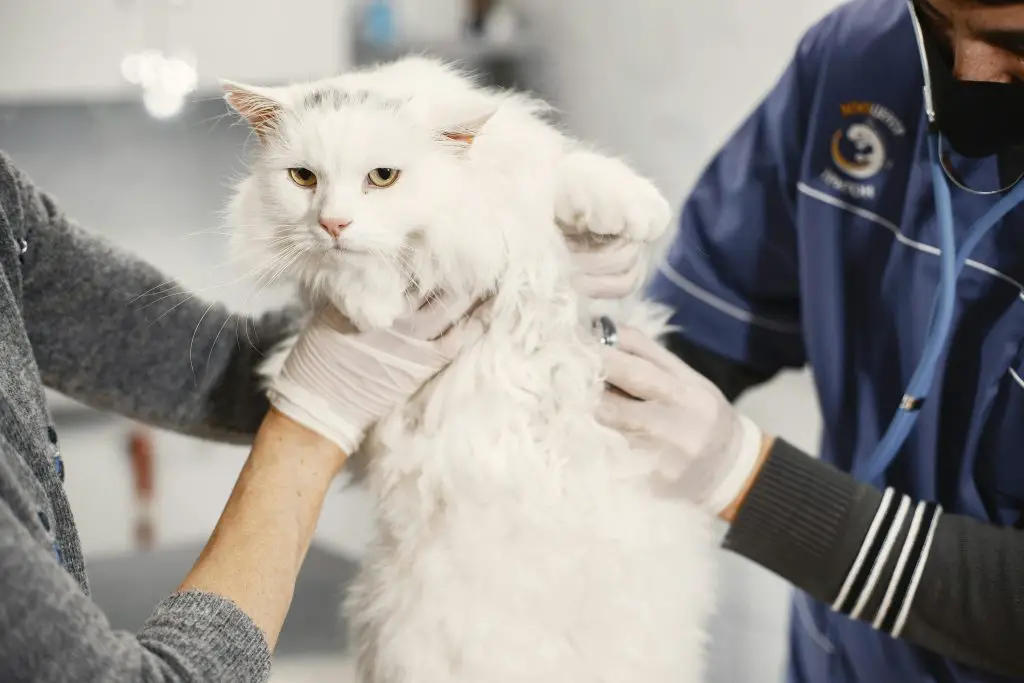Just as the ancient Greeks sought the Oracle of Delphi for answers to life’s mysteries, you’re seeking wisdom on how to determine your cat’s sex. You gaze at your feline friend, wondering if that adorable ball of fluff is a boy or girl.
While it may seem a challenging task, there are subtle signs that can reveal your cat’s true nature. Take a closer look at your cat’s physical characteristics and behavior – you might be surprised at what you discover. But what exactly should you be looking for?
Table of Contents
Key Takeaways
- Observe physical characteristics, such as overall size, body shape, and coat patterns, to determine sex, but note breed variations can affect accuracy.
- Perform a genital examination to identify testicles in males, or confirm the absence of testicles and presence of a uterus in females.
- Analyze behavioral patterns, including playfulness, grooming habits, vocal tones, and social interactions, to infer sex, but consider individual variations.
- Examine territorial behaviors, such as spraying or mounting, and dominant postures, like arched backs and puffed chests, to determine male characteristics.
- Consult a veterinarian for a definitive sex determination, especially if inexperienced, as they can perform thorough examinations and additional tests for confirmation.
Examine Your Cat’s Physical Characteristics
Examining your cat’s physical characteristics is crucial in determining its sex. You’ll need to observe its overall body size, coat patterns, and other distinguishing features. Take note of your cat’s weight and length, as males tend to be larger than females. However, this isn’t a definitive indicator, as some breeds can exhibit different growth patterns.
Some breeds, like the Siberian cat, have thick, long fur that can make size differences less apparent. Additionally, certain cat breeds may have unique physical traits that can influence their overall appearance regardless of sex.
Inspect your cat’s coat patterns, as certain patterns are more common in one sex than the other. For example, tortoiseshell cats are almost always female, while calico cats are typically female as well. However, these patterns aren’t exclusive to females, and some males can display similar coat patterns.
This post contains affiliate links. However all the information provided on this site are my own honest opinions. See more in Disclaimer.
You should also examine your cat’s head shape, ear size, and tail length, as these features can vary between males and females. Record your observations to help you make an informed decision about your cat’s sex.
It’s crucial to be thorough and objective when examining your cat’s physical characteristics to avoid any potential misidentification. By carefully evaluating these characteristics, you can make an educated guess about your cat’s sex.
Look for Visual Sex Differences of Your Cat
Several key visual differences can help you determine your cat’s sex. You’ll want to examine your cat’s overall body shape, coat patterns, and tail length.
Males tend to be larger and more muscular than females, with a broader face and a shorter, more rounded coat. Females, on the other hand, have a slender face and a longer, more pointed coat.
Additionally, observing your cat’s behavior, such as headbutting or bunting, can provide insights into its personality and potentially its sex, as some behaviors are more common in one sex than the other.
Coat patterns can also provide clues about your cat’s sex. Tortoiseshell and calico patterns, for example, are almost always found in females, as these patterns are the result of X-chromosome inactivation. Males, having only one X chromosome, are less likely to display these patterns.
Tail length is another visual cue to look for. Males tend to have shorter tails than females, with an average length of around 10 inches compared to the female’s 12 inches.
Keep in mind that these are general trends, and there’s some overlap between the sexes. Nevertheless, by examining these visual characteristics, you can make an educated guess about your cat’s sex.
It’s crucial to combine these observations with other diagnostic methods to guarantee accuracy.
Check for Testicles or Uterus of Your Cat
You’ll need to examine your cat’s genital area to locate the testicles, which are usually visible in males.
Regular grooming can help familiarize you with your cat’s anatomy and make this process easier.
Gently lift your cat’s tail and check the area just below the anus; if you feel two small, firm, oval-shaped structures, your cat is likely male.
To confirm a female cat, you’ll need to check the abdomen for a uterus, which requires a more thorough examination.
Locating the Testicles of Your Cat
The male cat’s reproductive anatomy can be distinguished by the presence of testicles, which are usually located in a sac-like structure called the scrotum. To locate the testicles, you’ll need to gently lift your cat’s tail and examine the area underneath.
The scrotum is typically located near the base of the tail, and the testicles are usually palpable within it. If you’re having trouble finding the testicles, try gently pressing on the scrotum to feel for the firm, oval-shaped organs. Regular examination of your cat’s reproductive organs is important, as changes or abnormalities could be early signs of health issues such as diabetes in cats.
Identifying the testicles is an essential step in determining your cat’s sex. If you can feel the testicles, it’s likely that your cat is male. The testicle location is a significant indicator of male identification, as females don’t have testicles.
Keep in mind that some males may have undescended testicles, which can make identification more challenging. However, if you’re able to locate the testicles, you can be reasonably certain that your cat is male. By checking for the presence of testicles, you can take a significant step in determining your cat’s sex and ensuring their reproductive health.
Checking the Abdomen
Beyond examining the scrotum, checking the abdomen is another vital step in determining your cat’s sex. You’ll perform an abdominal inspection to feel for the presence of testicles or a uterus. This method is particularly useful for kittens or cats that have been neutered or spayed.
Understanding cat body language can help you interpret your cat’s comfort level during the examination, ensuring a positive experience for both of you.
To perform the abdominal inspection, gently press your fingers into your cat’s abdominal cavity, feeling for any lumps or masses. In males, you may be able to feel the testicles, which are usually located near the base of the penis.
In females, you may be able to feel the uterus, which is typically located near the pelvic bone. Be careful not to press too hard, as this can be uncomfortable for your cat.
If you’re unsure about what you’re feeling, it’s always best to consult with a veterinarian. Accurate gender determination is essential for providing proper care and preventing unwanted breeding.
Observe Your Cat’s Behavior
Observe Your Cat’s Behavior
Observing the behavior of kittens and adult cats can provide clues about their sex, particularly if examined in conjunction with physical characteristics. You can look for differences in playful interactions and grooming habits. Males tend to be more aggressive and playful, while females are generally more affectionate and gentle.
| Behavior | Male | Female |
|---|---|---|
| Playful Interactions | More aggressive, roughhousing | Less aggressive, more gentle |
| Grooming Habits | Spend less time grooming | Spend more time grooming, especially kittens |
| Vocalization | Deeper, louder meows | Higher-pitched, softer meows |
| Socialization | More independent, aloof | More social, affectionate |
Keep in mind that these behavioral differences are not absolute and can vary between individuals. Factors such as spaying/neutering, breed, and environment can influence behavior.
It’s important to combine behavioral observations with physical characteristics to make an accurate determination of your cat’s sex. By observing your cat’s behavior and physical traits, you can make a more informed assessment of their sex.
Watch for Certain Posture Clues
Several posture clues can help you determine your cat’s sex. You’ll want to observe your cat’s body language, particularly when it’s interacting with other cats or marking its territory.
Males tend to exhibit more territorial behavior, such as spraying or mounting, and will often display a more dominant posture. They’ll arch their back, puff out their chest, and hold their tail high.
This behavior is closely related to marking territory, as cats use various methods to establish their presence and ownership. Understanding these behaviors can help you better interpret your cat’s actions and needs.
Trending in Cats:
In contrast, females tend to exhibit more submissive behavior, such as crouching or rolling onto their side. They’ll often display a more relaxed posture, with their ears up and tail hanging loose.
When interacting with other cats, females will often rub their faces and bodies against each other, which is a sign of affection and social bonding.
Check for Spaying or Neutering
You can determine if your cat has been spayed or neutered by checking for a scar on its abdomen.
Pet pillers can also be used to administer post-surgery medications if needed.
Typically, a spay or neuter surgery leaves a visible scar, usually located near the cat’s belly button.
Look for the Scar
After gently lifting your cat’s abdomen, inspect the area for a small scar, typically found near the base of the abdomen or on the flank, which can indicate that the cat has been spayed or neutered.
Scar identification is essential in determining your cat’s reproductive status. A spay or neuter scar is usually a small, thin line, about 1-2 cm in length. The scar may be more visible if your cat has a short or thin coat.
This process is part of responsible pet ownership and can help prevent feline depression by reducing stress-related behaviors associated with mating instincts.
When inspecting the scar, look for healing signs such as a change in the color or texture of the skin, indicating that the wound has fully closed. You may also notice a slight indentation or a faint line where the incision was made.
If you’re still unsure about the presence of a scar, gently run your fingers over the area to detect any subtle changes in the skin. If you detect a scar, it’s likely that your cat has been spayed or neutered.
However, the absence of a scar doesn’t necessarily mean that your cat hasn’t been spayed or neutered, as some veterinarians may use alternative methods that don’t leave a visible scar.
Check for Ear Tags
Inspecting for a spay or neuter scar is just one method of determining your cat’s reproductive status. You should also check for ear tags, which are used for identification purposes in many spay/neuter programs.
Ear tag identification is a common practice in animal welfare organizations and veterinary clinics. If your cat has an ear tag, it’s likely that it has been spayed or neutered. Positive reinforcement can be used to help your cat become more comfortable with ear examinations, making the process easier for both you and your pet.
When identifying ear tags, look for a small metal or plastic tag attached to the cat’s ear. The tag may be colored, numbered, or have other identifying marks. Ear tags are usually placed on the left ear, but this can vary depending on the organization or clinic that performed the spay/neuter surgery.
If you find an ear tag on your cat, it’s likely that it has been spayed or neutered. However, the absence of an ear tag doesn’t necessarily mean that the cat hasn’t been spayed or neutered. You should still check for a spay/neuter scar or consult with a veterinarian to confirm your cat’s reproductive status.
Accurate ear tag identification can provide valuable information about your cat’s medical history.
Consult a Veterinarian Expertise
Determining the sex of a cat can be a challenging task, especially for inexperienced cat owners. If you’re still unsure about your cat’s sex after checking for physical characteristics and ear tags, it’s time to consult a veterinarian.
A vet consultation is the most reliable way to determine your cat’s sex, as veterinarians have the necessary expertise and equipment to perform a thorough examination. Veterinarians can also provide valuable advice on cat carrier selection for safe transportation to and from appointments, ensuring your cat’s comfort during the visit.
During the consultation, the veterinarian will examine your cat’s reproductive organs, check for any sex-specific characteristics, and provide professional advice on your cat’s sex.
The veterinarian may also perform additional tests, such as ultrasound or genetic testing, to confirm the sex of your cat. By seeking the expertise of a veterinarian, you’ll receive an accurate diagnosis and avoid any potential health risks associated with incorrect sex identification.
Don’t hesitate to schedule a vet consultation if you’re unsure about your cat’s sex, as it’s essential for providing the best possible care for your feline companion.
Frequent Questions and Answers
Like solving a puzzle, you can accurately determine your cat’s sex at any age by examining kitten anatomy and observing behavioral differences, which become more pronounced as they mature, allowing you to make an informed identification.
You’ll examine the deceased cat’s physical characteristics, such as the presence or absence of testicles or a uterus, and consider behavioral differences noted before death, if any, to determine its sex during a post-mortem evaluation.
When sexing a newborn kitten, you risk causing harm due to their delicate kitten anatomy. Inaccurate sexing techniques can lead to incorrect identification, which may result in inappropriate care or treatment, compromising the kitten’s health.
You’d think determining sex would be a breeze, but surprise! Certain medical conditions can play a pesky game of hide-and-seek with genetic factors and hormonal influences, making sex determination a complex puzzle to solve, even for experts.
You can utilize DNA testing to determine your cat’s sex through genetic markers that identify specific feline chromosomes. This method is particularly useful when sex determination is uncertain due to various medical conditions or inconclusive physical examinations.





















